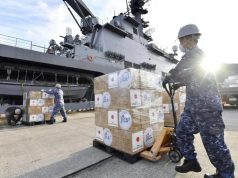SYDNEY/SHANGHAI — Britain plans to send a warship to the disputed South China Sea next year to conduct freedom of navigation exercises, Defense Minister Michael Fallon said on Thursday, a move likely to anger Beijing.
The announcement came as China’s state broadcaster reported the Chinese air force will keep conducting drills at sea regardless of whatever interference it may encounter. This followed reports Chinese warplanes flew near Japan and Taiwan in recent days.
Britain would increase its presence in the South China Sea after it sent four British fighter planes for joint exercises with Japan in the region last year, Fallon said.
China claims most of the energy-rich sea where neighbors Brunei, Malaysia, the Philippines, Taiwan and Vietnam also have claims.
“We hope to send a warship to region next year. We have not finalized exactly where that deployment will take place but we won’t be constrained by China from sailing through the South China Sea,” Fallon told Reuters.
“We have the right of freedom of navigation and we will exercise it.”
The presence of a British vessel threatens to stoke tensions, escalated by China’s naval build-up and its increasingly assertive stance.
“The air force’s distant sea training has become normal, systemic and practical,” China Central Television quoted air force spokesman Shen Jinke late on Thursday as saying.
The operations “have faced and dealt with a variety of forms of interference and obstruction, but no matter the obstruction we will carry on just as in the past,” Shen said.
“No matter who shadows us we will fly often and frequently,” he said, adding that the flights were legal and reasonable.
The comments by Fallon came after Britain’s Foreign Secretary Boris Johnson said the country’s two new aircraft carriers would be sent to the region.
Johnson did not specify where exactly the vessels would be sent once operational in 2020, though the presence of such firepower will likely heighten tensions in the region.
China’s construction of islands and military facilities in the South China Sea has stoked international condemnation, amid concern Beijing is seeking to restrict free movement and extend its strategic reach.
Britain’s move could also upset ties between London and Beijing, undermining efforts to shore up what the two governments have called a “golden era” in their relationship as Britain heads towards a divorce with the European Union.
“We flew RAF Typhoons through the South China Sea last October and we will exercise that right whenever we next have the opportunity to do so, whenever we have ships or planes in the region,” Fallon said.
The United States estimates Beijing has added more than 3,200 acres (1,300 hectares) on seven features in the South China Sea over the past three years, building runways, ports, aircraft hangars and communications equipment.
To counter the perceived Chinese aggression, the United States has conducted regular freedom of navigation exercises that have angered Beijing.
Earlier this month, the United States sent two bombers over the region, coming just a few months after it sent a warship to carry out a maneuvering drill within 12 nautical miles of one of China’s artificial islands.
China has repeatedly denounced efforts by countries from outside the region to get involved in the South China Sea dispute.
The South China Sea is expected to dominate a regional security meeting in Manila next week, where Chinese Foreign Minister Wang Yi will meet counterparts from the Association of Southeast Asian Nations countries.
Meeting ASEAN diplomats in Beijing on Wednesday, Wang told them both sides must “exclude disturbances on the South China Sea issue, and maintain positive momentum,” China’s Foreign Ministry said.
The Chinese air force said on its microblog earlier this month its planes had recently flown through both the Miyako Strait — which lies between two southern Japanese islands — and the Bashi Channel that separates Taiwan and the Philippines.
China’s long-range flight drills at sea, which started three years ago, were not targeted at any specific country or region, Shen was quoted as saying.
But the flights have raised concern among China’s neighbors.
On Tuesday, Taiwan’s defense ministry responded to a series of recent flybys by Chinese fighter and reconnaissance aircraft, saying the self-governed island was prepared to defend itself against China.
Beijing claims Taiwan as a part of China and has never ruled out the use of force to bring Taiwan under its control, warning that any moves towards formal independence could prompt an armed response.
Japan’s air force regularly scrambles jets to monitor and chase away nearby Chinese military planes, fearing that China’s probing of its air defenses is part of a push to extend its military influence in the East China Sea and western Pacific, where Japan controls an island chain stretching 1,400 km (870 miles) south towards Taiwan.










